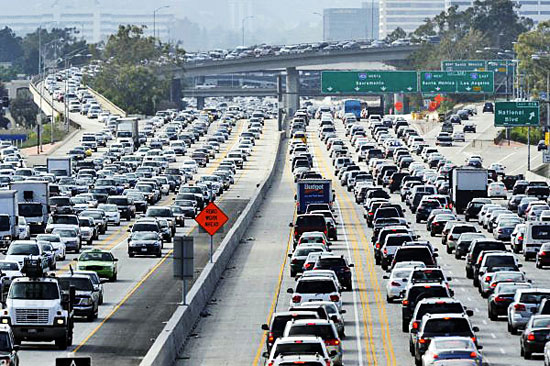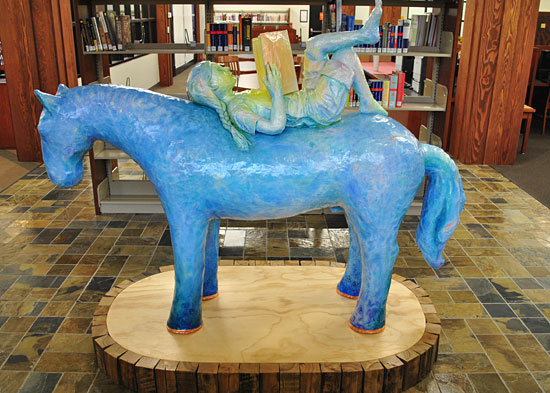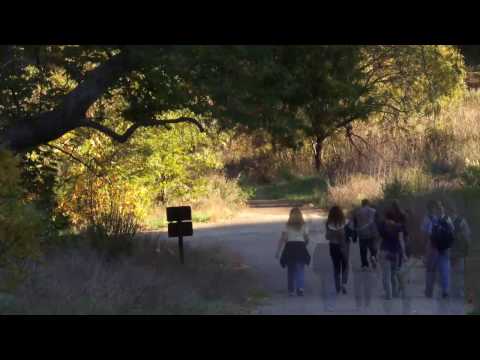February 13, 2014
No Comments

If too many motorists converge on the 405 this weekend, Jamzilla will live up to its name.
With officials keeping a close eye on the weather report and a couple of major sporting events, the gargantuan road-paving and lane-painting operation known as Jamzilla roars into action on the 405 Freeway this weekend.
In the days leading up to the 80-hour construction marathon, which runs from February 14-18, the weather forecast has been of more than casual interest. That’s because a cornerstone of the planned work—a costly, fast-hardening polyester paving process that allows the contractor to move far more quickly than would be possible with conventional paving materials—requires temperatures above 50 degrees (and below 100 degrees) to work properly. With a warming trend pushing overnight lows into the 50s, officials held a “go/no-go” meeting on Wednesday and decided to proceed with the effort, which is a key milestone in the long-running project to bring a 10-mile northbound carpool lane and other improvements to the 405.
But the thermometer hasn’t been the only preoccupation as Jamzilla approaches.
Officials also are worried about the human factor.
While L.A. sailed through two previous weekend-long “Carmageddons” in which the entire 405 was shut down, this time around may be a different story—paradoxically, because the freeway will actually have a couple of northbound lanes open during the daytime all weekend long, as well as all of the southbound lanes.
“When the freeway is closed, it’s easy for someone to make the decision. But with lane reductions, it means there’s always a chance. There’ll be some people who’ll just go there and see what happens,” said Edward Yu, who directs the city of Los Angeles’ Automated Traffic Surveillance and Control Center (ATSAC), which will be closely monitoring the flow of traffic as Jamzilla unfolds.
Also, unlike during either of the previous Carmageddons, there are a couple of big sports events scheduled in the area and expected to draw thousands of spectators: the Northern Trust Open at the Riviera Country Club, starting Thursday and running through Sunday, February 16, and the UCLA-University of Utah basketball game at Pauley Pavilion on Saturday.
The Getty Center, meanwhile, is open for visitors and showcasing a Queen Victoria film series this weekend, along with ongoing exhibitions. Another Sepulveda Pass institution, the Skirball Cultural Center, is offering its regular weekend lineup of programs.
Metro, which is running the 405 Project in conjunction with Caltrans, estimates it will need to reduce the regular traffic volume on the 405 by two-thirds just to keep things moving normally.
Anything else, they warned this week, could produce an “80-hour-long Sigalert.”
“If we don’t have enough people staying off the freeway, we will have long congestion lines. That’s guaranteed,” said Metro spokesman Dave Sotero. “One-and-a-half or two hours stuck on the freeway is no fun for anybody—and it could be even worse.”
He’s not just blowing smoke. A shorter, but otherwise similar paving operation last March, billed as “Son of Carmageddon,” caused lengthy traffic jams on the 405, Sepulveda Boulevard and beyond.
“We had northbound traffic backed up to the 90. The 10 was gridlocked in both directions leading to the 405,” recalled Sotero, who memorialized the occasion with a frame grab of all the red lines depicting clogged roadways on that day’s Caltrans QuickMap.
It doesn’t have to be that way this weekend.
Anyone who doesn’t need to drive should make it a car-free weekend, Metro advises. Those who do need to travel should steer clear of the construction zone and choose other freeways to get around.
And everybody who plans to be in motion anywhere near the 405 this weekend, including on the Presidents’ Day holiday Monday, should make it a point to be up to date on exactly where and when Jamzilla is taking place.
Full details are here, but in a nutshell, this is what’s happening:
The affected area is a 5.6-mile stretch of the northbound 405 between Getty Center Drive and Ventura Boulevard.
During the daytime hours, three northbound lanes will be closed, with two left open.
At night, all five northbound lanes will be closed.
The entire operation should wrap up in time for back-to-work traffic at 6 a.m. on Tuesday, February 18.
Unfortunately, this is not the final extended closure planned for the project, which is expected to be “substantially completed” and open for driving by summer.
A 55-hour closure of the southbound freeway is now in the planning stages. A date has not yet been set, but K.N. Murthy, Metro’s executive director of transit project delivery, said the upcoming extended shutdown is needed to work on retaining walls, sound walls, shoulder paving and lane restriping.
When the $1 billion-plus project finally reaches the end of the road, it will leave behind the 10-mile-long carpool lane, three rebuilt bridges and some dramatically reconfigured Wilshire “flyover” ramps, along with other improvements.
Another benefit, for transit riders, may in the offing as well.
When the new carpool lane opens this summer, Metro is considering using it to introduce a new rapid bus line between the San Fernando Valley and the Westside. If approved and funded by Metro’s Board of Directors, the new line could offer service from the Valley to Westwood beginning this summer, and would extend further south to connect with the Expo Line when the second phase of the light rail opens to Santa Monica in 2015.
Posted 2/13/14










































